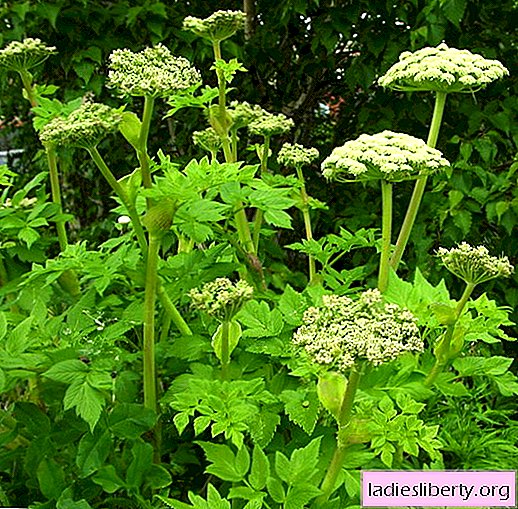
Angelica - General Description
Dudnik (Angélica sylvestris) - herbaceous biennial or perennial plant belonging to the family of umbelliferous. The root is thick, short, pivotal, the stem is erect, arched, hollow. The leaves are cirrus, up to 80 cm long. The flower is small, white (possibly greenish-yellow or pinkish), consists of a complex umbrella. The fruit is a two-seeded, flattened from the back, has pterygoid marginal ribs. Angelica has a strong specific smell of rhizomes and stem, flowering period - from June to August. In early summer, angelica is used as an edible plant.
Angelica - types and places of growth
Initially, the north of Eurasia is considered to be the birthplace of the plant. Representatives of this genus are also found in areas of the Northern Hemisphere and New Zealand. In Russia, dozens of species of this plant are known, so the names may vary in different parts of the country. For example, apiaries, bumps, caddies, bunches, pipe, pipe grass, dzagel, digel, angelica, cowshed, stem, yagil, sweet trunk and many others (about 80 species in total). Ubiquitous in Russia (more often in the Far East), such species: marsh angelica, forest and medicinal. Prefers the banks of rivers, streams, wet meadows.
Angelica - healing properties
Angelica officinalis has a lot of medicinal properties associated primarily with acute respiratory infections. The list of diseases whose symptoms can be alleviated with the help of this medicinal plant covers almost all human organs. These are bronchitis, laryngitis, hepatitis, flatulence, gastric colic, gastritis, peptic ulcer of the stomach and duodenum, kidney disease. In addition, it is used as an expectorant, anthelmintic, antitumor, diuretic, antispasmodic. External use of this plant is possible in the form of compresses for rheumatism and toothache. Angelica treat such an unpleasant disease as pediculosis. Studies show that the stimulation of estrogen production that this plant causes can be used in gynecology: the angelica forest can ease pain during critical days in women and facilitate the release of the placenta during childbirth.
Angelica - dosage forms
In order to make medicines, the plant uses roots, shoots, fruits. Produced angelica oil is used as a tonic, root juice as an anesthetic for pain in the ear and teeth. The roots of the plant are similar in their properties to another close relative - common angelica. Fruits must be harvested after full ripening occurs, that is, at the end of summer. First, umbrellas need to be dried well, and only after that to collect seeds. The roots are dug up in the first year or after wintering. The healing properties of angelica are widely used in Chinese alternative medicine, as well as in Korea, Vietnam, Japan, Mongolia, and Tibet.
Angelica - recipes
In almost all diseases, an infusion of herbs is used externally and internally: boil 30 grams of grass for 5 minutes in 30 ml of water, leave for 2 hours, strain. Take 2 tablespoons inward, or for rinsing and bathing.
Powder from angelica roots is taken 2-3 times with colitis, gastritis, bloating.
Tea from angelica removes poisons during intoxication of the body.
Angelica - contraindications
Angelica is an unconventional medical tool that can cause overexcitation of the nervous system, so careful use is necessary. This herb is also dangerous because it causes photo-toxicity, that is, in large quantities it makes the body react negatively to the effects of sunlight. During pregnancy and diabetes, it is recommended to refrain from treatment.
Dudnik - interesting facts
- The wonderful Latin name of Angelica is Angelica in its origins means angelus, i.e., angel. According to mythological traditions, the Archangel Michael cured the plague using the phenomenon of angelica root.
- Angelica oil is widely used in perfumery and gin flavoring. It is contained in the well-known French brands of liquors "Benedictine" and "Chartreuse"
Comments
it’s easy to cook. For infusion, take 20 g of leaves and flowers, pour 200 ml of boiling water, insist on a water bath for 15 minutes, cool for 45 minutes, filter. Take 2 tablespoons 3-4 times a day. full list of recipes here - //kakvyrastit.ru/dikorosy-lekarstvennye/dudnik/











